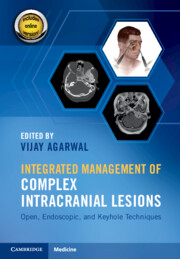Book contents
- Integrated Management of Complex Intracranial Lesions
- Integrated Management of Complex Intracranial Lesions
- Copyright page
- Dedication
- Contents
- Contributors
- Foreword
- Section I Endoscopic Endonasal (EN) Combined Approaches
- Chapter 1 Combined Endonasal Transethmoidal, Transcribriform, and Endoscope-Assisted Supraorbital Craniotomy
- Chapter 2 Combined Endonasal and Transorbital Approach
- Chapter 3 Combined Endonasal and Transoral Endoscopic Approach to the Craniovertebral Junction
- Chapter 4 Combined Endoscopic Endonasal and Transcervical Approach
- Chapter 5 Combined Endoscopic Endonasal and Transcranial Approach to Complex Intracranial Lesions
- Section II Open Combined Approaches
- Index
- References
Chapter 2 - Combined Endonasal and Transorbital Approach
from Section I - Endoscopic Endonasal (EN) Combined Approaches
Published online by Cambridge University Press: 05 October 2021
- Integrated Management of Complex Intracranial Lesions
- Integrated Management of Complex Intracranial Lesions
- Copyright page
- Dedication
- Contents
- Contributors
- Foreword
- Section I Endoscopic Endonasal (EN) Combined Approaches
- Chapter 1 Combined Endonasal Transethmoidal, Transcribriform, and Endoscope-Assisted Supraorbital Craniotomy
- Chapter 2 Combined Endonasal and Transorbital Approach
- Chapter 3 Combined Endonasal and Transoral Endoscopic Approach to the Craniovertebral Junction
- Chapter 4 Combined Endoscopic Endonasal and Transcervical Approach
- Chapter 5 Combined Endoscopic Endonasal and Transcranial Approach to Complex Intracranial Lesions
- Section II Open Combined Approaches
- Index
- References
Summary
It is often necessary to use more than one skull base approach for the treatment of complex lesions to maximize resection and minimize morbidity and mortality. The advent of widespread endoscope use has increased the armamentarium for skull base surgeons to tackle these dangerous tumors and lesions. A combined endoscopic transnasal and simultaneous transorbital approach allows for minimally invasive multiportal surgery to reach difficult-to-access skull base regions with minimal collateral damage. Multiple surgical trajectories can be readily and safely obtained in a minimally invasive manner. The use of standard zero-degree endoscopes via this approach allows for easier and safer manipulation of the target lesion. In this way, multistage or more invasive surgery can often be avoided, minimizing complications, and lesions can be removed en-bloc.
- Type
- Chapter
- Information
- Integrated Management of Complex Intracranial LesionsOpen, Endoscopic, and Keyhole Techniques, pp. 9 - 24Publisher: Cambridge University PressPrint publication year: 2021



